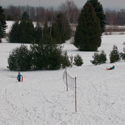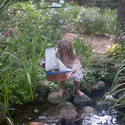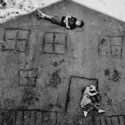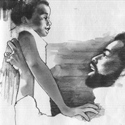John Hubley was an animator for Disney during the days of Snow White, Pinocchio, and Bambi. After he was blacklisted for refusing to name names before the House Committee on Un-American Activities, he went on to create uncredited television commercials, and eventually shifted his focus to independent short films after moving to New York and marrying Faith Elliot, who became his partner and collaborator at Storyboard Films.
The Hubleys' Storyboard animation would be familiar to anyone who has seen classic Electric Company and Sesame Street from the early 1970s---it had a distinct style that was low-key, a bit jittery, and often surreal. As I've been trying to update my list of YouTube offerings that I use to entertain Juniper instead of television, I realized that a lot of my favorite old Electric Company and Sesame Street animations were created by the Hubleys; I recently looked into their story and some of the others films they created, and stumbled across this:
"Georgie," the younger girl whose tantrum erupts into a green feline beastie at 5:00, grew up to become Georgia Hubley of Hoboken (the drummer for Yo La Tengo). The older girl, Emily, followed in her parents' footsteps (she did the animation in John Cameron Mitchell's Hedwig and the Angry Inch). Beyond that trivia, I am struck by this cartoon's simple genius: the girls seem to be mic'd up and playing without any interference from their parents, and the use of animation here is so perfect, from the way it effectively conveys the imaginative play of preschoolers to how it captures the true ferocity of a sudden tantrum like no video camera ever could. But beyond that, and even beyond the unscripted reality of the subject, what I see in this animation is the love of the parents for their children, such a patient, tender understanding and appreciation of these two kids for who they are right in those moments and the amazing world they inhabit together. I sit watching it as enraptured as Juniper. She is doing a lot of this kind of imaginative babbling and quiet play herself these days, and this makes me want to give her a sibling.
Along the same lines is the Hubleys' earlier short film Moonbird, an Academy Award winner from 1959, that uses gorgeous mid-century-feeling animation and a similarly-recorded dialogue between their older sons as they hunt for an imaginary creature in the middle of the night:
I was struck by how revolutionary these decades-old cartoons felt when I was first saw them. I think it's because the voices are not supplied by actors, the stories not plotted by a team of writers. The voices are those of real children, and the action is supplied organically by one of the most powerful creative forces around: the imagination of preschoolers. But as I watched each of those videos for the first time, I had a hard time imagining two preschoolers raised in the current culture of pervasive branding sustaining a conversation for eight or ten minutes without talking about Dora or Spongebob or Thomas or Bob the Builder or whatever other preschool icon has hijacked their imagination.
Then I shook my cane at the kids these days and told them to get off my lawn.
Copyright © 2005-2016 Sweet Juniper Media, Inc.
All Rights Reserved.
All Rights Reserved.
"Sweet Juniper" is a registered trademark.
No unauthorized reuse.
No unauthorized reuse.
Categories
- Friday Morning Street Urchin Blogging ( 107 )
- Detroit ( 60 )
- SAHD ( 34 )
- photography ( 30 )
- Thursday Morning Wood ( 25 )
- Halloween ( 23 )
- Thrift ( 18 )
- abandoned places ( 18 )
- terrifying nixon-era children's books ( 16 )
- Reminiscin' ( 15 )
- Sweet Juniper Media ( 11 )
- Wendell ( 10 )
- Design ( 9 )
- San Francisco ( 9 )
- nature fights back ( 9 )
- sleep ( 9 )
- if you ain't dutch you ain't much ( 8 )
- sentimental ( 7 )
- Music ( 6 )
- Parody ( 6 )
- birth story ( 6 )
- scrappers ( 6 )
- Sweet Juniper Tunes ( 5 )
- lawyering ( 5 )
- Zoo ( 4 )
- elegant leisure ( 4 )
- language ( 3 )
- feral houses ( 2 )
- theme parks of the damned ( 2 )
- zombies ( 1 )
Archives
- November 2017 ( 2 )
- December 2016 ( 1 )
- November 2016 ( 2 )
- December 2015 ( 1 )
- November 2015 ( 2 )
- December 2014 ( 1 )
- October 2014 ( 2 )
- April 2014 ( 1 )
- December 2013 ( 2 )
- November 2013 ( 1 )
- October 2013 ( 1 )
- September 2013 ( 2 )
- July 2013 ( 2 )
- June 2013 ( 1 )
- April 2013 ( 1 )
- March 2013 ( 3 )
- February 2013 ( 1 )
- January 2013 ( 1 )
- December 2012 ( 2 )
- November 2012 ( 1 )
- October 2012 ( 4 )
- September 2012 ( 2 )
- August 2012 ( 2 )
- July 2012 ( 1 )
- June 2012 ( 3 )
- May 2012 ( 1 )
- April 2012 ( 2 )
- March 2012 ( 1 )
- February 2012 ( 2 )
- January 2012 ( 1 )
- December 2011 ( 3 )
- November 2011 ( 3 )
- October 2011 ( 5 )
- September 2011 ( 3 )
- August 2011 ( 4 )
- July 2011 ( 4 )
- June 2011 ( 2 )
- May 2011 ( 4 )
- April 2011 ( 6 )
- March 2011 ( 7 )
- February 2011 ( 4 )
- January 2011 ( 4 )
- December 2010 ( 5 )
- November 2010 ( 7 )
- October 2010 ( 5 )
- September 2010 ( 4 )
- August 2010 ( 5 )
- July 2010 ( 7 )
- June 2010 ( 5 )
- May 2010 ( 5 )
- April 2010 ( 5 )
- March 2010 ( 4 )
- February 2010 ( 5 )
- January 2010 ( 5 )
- December 2009 ( 6 )
- November 2009 ( 5 )
- October 2009 ( 8 )
- September 2009 ( 9 )
- August 2009 ( 6 )
- July 2009 ( 9 )
- June 2009 ( 8 )
- May 2009 ( 8 )
- April 2009 ( 8 )
- March 2009 ( 12 )
- February 2009 ( 11 )
- January 2009 ( 9 )
- December 2008 ( 11 )
- November 2008 ( 9 )
- October 2008 ( 14 )
- September 2008 ( 11 )
- August 2008 ( 11 )
- July 2008 ( 12 )
- June 2008 ( 10 )
- May 2008 ( 9 )
- April 2008 ( 8 )
- March 2008 ( 10 )
- February 2008 ( 15 )
- January 2008 ( 12 )
- December 2007 ( 9 )
- November 2007 ( 12 )
- October 2007 ( 11 )
- September 2007 ( 13 )
- August 2007 ( 11 )
- July 2007 ( 8 )
- June 2007 ( 12 )
- May 2007 ( 10 )
- April 2007 ( 10 )
- March 2007 ( 12 )
- February 2007 ( 14 )
- January 2007 ( 12 )
- December 2006 ( 11 )
- November 2006 ( 10 )
- October 2006 ( 13 )
- September 2006 ( 8 )
- August 2006 ( 13 )
- July 2006 ( 13 )
- June 2006 ( 15 )
- May 2006 ( 13 )
- April 2006 ( 9 )
- March 2006 ( 10 )
- February 2006 ( 3 )
- January 2006 ( 5 )
- December 2005 ( 2 )
- November 2005 ( 8 )
- October 2005 ( 4 )
- September 2005 ( 1 )
- July 2005 ( 3 )


























